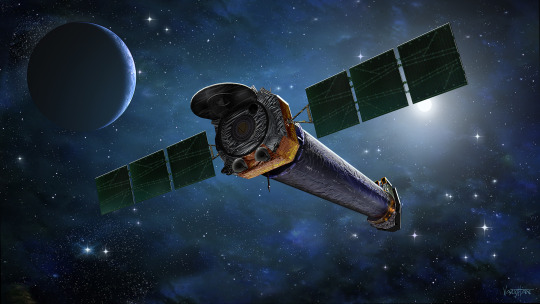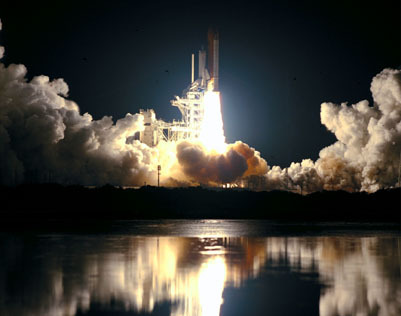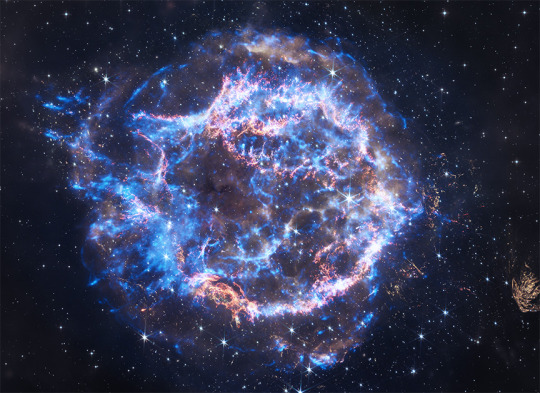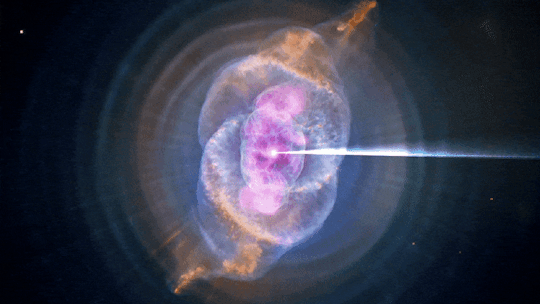Text



🔗 SOPPY/DUSTCELL - sh1an(cover)
・「SOPPY」カバーのイラスト
・twitchのサブスクライバーバッジデザイン
それぞれ担当させていただいておりました!
sh1an 様:X / YouTube / twitch
71 notes
·
View notes
Text
チャンドラセカール限界質量 絶対温度が0度の電子の縮退圧により支えられる天体(白色矮星や大質量星中心の縮退した鉄のコアなど)が安定して存在できる質量の上限値。単にチャンドラセカール質量とも言う。チャンドラセカール限界質量の値は天体の化学組成による。その天体を構成する原子の原子核中の核子(陽子と中性子)の総数(質量数)を電子数で割った値を電子1個あたりの平均分子量(ヘリウムや炭素の場合は2で、さまざまな原子が混じっている場合はそれらの平均値となる)と言い、それをμeとすると、チャンドラセカール限界質量は太陽質量の約1.46(2/μe)2倍となる。白色矮星や鉄のコアがこの質量を超えると、質量に応じて最終的には中性子星やブラックホールになる。このことを発見したチャンドラセカール(Subrahmanyan Chandrasekhar)は、1983年のノーベル物理学賞を受賞した。
0 notes
Text
25 Years of Exploring the Universe with NASA's Chandra Xray Observatory

Illustration of the Chandra telescope in orbit around Earth. Credit: NASA/CXC & J. Vaughan
On July 23, 1999, the space shuttle Columbia launched into orbit carrying NASA’s Chandra X-ray Observatory. August 26 marked 25 years since Chandra released its first images.
These were the first of more than 25,000 observations Chandra has taken. This year, as NASA celebrates the 25th anniversary of this telescope and the incredible data it has provided, we’re taking a peek at some of its most memorable moments.
About the Spacecraft
The Chandra telescope system uses four specialized mirrors to observe X-ray emissions across the universe. X-rays that strike a “regular” mirror head on will be absorbed, so Chandra’s mirrors are shaped like barrels and precisely constructed. The rest of the spacecraft system provides the support structure and environment necessary for the telescope and the science instruments to work as an observatory. To provide motion to the observatory, Chandra has two different sets of thrusters. To control the temperatures of critical components, Chandra's thermal control system consists of a cooling radiator, insulators, heaters, and thermostats. Chandra's electrical power comes from its solar arrays.
Learn more about the spacecraft's components that were developed and tested at NASA’s Marshall Space Flight Center in Huntsville, Alabama. Fun fact: If the state of Colorado were as smooth as the surface of the Chandra X-ray Observatory mirrors, Pike's Peak would be less than an inch tall.

Engineers in the X-ray Calibration Facility at NASA’s Marshall Space Flight Center in Huntsville, Alabama, integrating the Chandra X-ray Observatory’s High-Resolution Camera with the mirror assembly, in this photo taken March 16, 1997. Credit: NASA
Launch
When space shuttle Columbia launched on July 23, 1999, Chandra was the heaviest and largest payload ever launched by the shuttle. Under the command of Col. Eileen Collins, Columbia lifted off the launch pad at NASA’s Kennedy Space Center in Florida. Chandra was deployed on the mission’s first day.

Reflected in the waters, space shuttle Columbia rockets into the night sky from Launch Pad 39-B on mission STS-93 from Kennedy Space Center. Credit: NASA
First Light Images
Just 34 days after launch, extraordinary first images from our Chandra X-ray Observatory were released. The image of supernova remnant Cassiopeia A traces the aftermath of a gigantic stellar explosion in such captivating detail that scientists can see evidence of what is likely the neutron star.
“We see the collision of the debris from the exploded star with the matter around it, we see shock waves rushing into interstellar space at millions of miles per hour,” said Harvey Tananbaum, founding Director of the Chandra X-ray Center at the Smithsonian Astrophysical Observatory.

Cassiopeia A is the remnant of a star that exploded about 300 years ago. The X-ray image shows an expanding shell of hot gas produced by the explosion colored in bright orange and yellows. Credit: NASA/CXC/SAO
A New Look at the Universe
NASA released 25 never-before-seen views to celebrate the telescopes 25th anniversary. This collection contains different types of objects in space and includes a new look at Cassiopeia A. Here the supernova remnant is seen with a quarter-century worth of Chandra observations (blue) plus recent views from NASA’s James Webb Space Telescope (grey and gold).

This image features deep data of the Cassiopeia A supernova, an expanding ball of matter and energy ejected from an exploding star in blues, greys and golds. The Cassiopeia A supernova remnant has been observed for over 2 million seconds since the start of Chandra’s mission in 1999 and has also recently been viewed by the James Webb Space Telescope. Credit: NASA/CXC/SAO
Can You Hear Me Now?
In 2020, experts at the Chandra X-ray Center/Smithsonian Astrophysical Observatory (SAO) and SYSTEM Sounds began the first ongoing, sustained effort at NASA to “sonify” (turn into sound) astronomical data. Data from NASA observatories such as Chandra, the Hubble Space Telescope, and the James Webb Space Telescope, has been translated into frequencies that can be heard by the human ear.
SAO Research shows that sonifications help many types of learners – especially those who are low-vision or blind -- engage with and enjoy astronomical data more.
Click to watch the “Listen to the Universe” documentary on NASA+ that explores our sonification work: Listen to the Universe | NASA+

An image of the striking croissant-shaped planetary nebula called the Cat’s Eye, with data from the Chandra X-ray Observatory and Hubble Space Telescope. NASA’s Data sonification from Chandra, Hubble and/or Webb telecopes allows us to hear data of cosmic objects. Credit: NASA/CXO/SAO
Celebrate With Us!
Dedicated teams of engineers, designers, test technicians, and analysts at Marshall Space Flight Center in Huntsville, Alabama, are celebrating with partners at the Chandra X-ray Center and elsewhere outside and across the agency for the 25th anniversary of the Chandra X-ray Observatory. Their hard work keeps the spacecraft flying, enabling Chandra’s ongoing studies of black holes, supernovae, dark matter, and more.
Chandra will continue its mission to deepen our understanding of the origin and evolution of the cosmos, helping all of us explore the Universe.

The Chandra Xray Observatory, the longest cargo ever carried to space aboard the space shuttle, is shown in Columbia’s payload bay. This photo of the payload bay with its doors open was taken just before Chandra was tilted upward for release and deployed on July 23, 1999. Credit: NASA
Make sure to follow us on Tumblr for your regular dose of space: http://nasa.tumblr.com
2K notes
·
View notes
Text




★ 【JLT4̴͇̓n̶͊̐】 「 ℍ𝔸ℙℙ𝕐 𝔹𝕀ℝ𝕋ℍ𝔻𝔸𝕐 ℝ𝕐𝕆 𝕐𝔸𝕄𝔸𝔻𝔸💙 」 ☆ ✔ republished w/permission ⊳ ⊳ follow me on twitter
383 notes
·
View notes
Text

「撮影も終わっだし今からみんなで飲みに行くけど、君も来たらど う? by サボテン [Twitter/X] ※Illustration shared with permission from the artist. If you like this artwork please support the artist by visiting the source.
256 notes
·
View notes
Photo
懐かしいですね・・・。










https://twitter.com/kotetsu_of/status/1148620388248633346
746 notes
·
View notes







